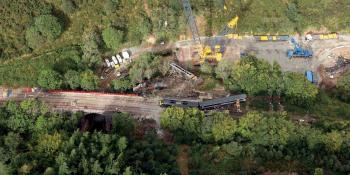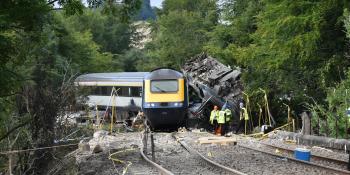
Rail safety body RSSB says rail is 20 times safer than travelling by car, and that modal shift away from rail would be detrimental to safety, health and the environment.
The findings were released in its annual health and safety report, published on 1 July. In 2020/21, three people died in the Carmont derailment on 12 August 2020, there were three workforce fatalities not in train accidents, one passenger death in a station, 16 other deaths (11 trespassers and five at level crossings) and 253 suicides or suspected suicides.
Despite a major reduction in passenger numbers and services during the Covid-19 pandemic, overall safety performance improved, with operating incidents falling by more than the reduction in services. Reduced fatigue was identified as a contributing factor as staff had more conventional working hours and more time to refresh skills and knowledge. Drivers may also have benefited from a more “pastoral” approach to driver management and more targeted and detailed feedback using information from on-train data recorders.
As the industry moves towards a post-pandemic environment, the RSSB is focusing on a number of areas. Top of the list is asset integrity, with infrastructure failures accounting for 12% of all modelled train accident risk: earthworks failures are the largest factor. Peaks seen in 2020/21 all coincide with periods of bad weather, and the long-term forecast is for more frequent extreme weather conditions exacerbated by climate change.
Workforce safety is another important area RSSB continues to monitor. Two workers were struck by trains, and a welding depot worker died at Eastleigh depot on 30 November 2020 when a rail was inadvertently moved into a machine they were maintaining. RSSB and the Infrastructure Safety Leadership Group are supporting Network Rail initiatives to improve track worker safety, including the move away from working with unassisted lookout and lookout operated warning systems protection. Unassisted lookout working now accounts for around 11% of work orders compared with around 20% in July 2019. The number of planned line blockages with additional protection has risen from 6% to 34% over the last year, helping to reduce the risk from signaller error.
There has also been a cut in the number of reported near misses, and while service reductions could have contributed, RSSB points out that infrastructure work has continued, and that NR has delivered most of its maintenance and upgrade programme.
SPAD risk
Although the number of signals passed at danger fell more sharply than train miles during the pandemic, RSSB says numbers are starting to rise to pre-pandemic levels, and that five incidents passed the conflict point with the potential for passenger train collision – similar to the recent annual average.
The number of staff assaults rose relative to the number of passengers in 2020/21, and RSSB says increased vigilance and support for affected staff is vital.
RSSB Director of System Safety and Health Ali Chegni said: ‘Fundamentally, our Annual Health and Safety Report 2020-1 shows that Britain’s railways can continue to be proud of a formidable safety record that makes the train far safer than other transport modes.
‘The fatal train accident at Carmont as well as the workforce fatalities at Roade and Surbiton show that we are not infallible. These are indicators of big challenges where improvement is needed, and where RSSB is playing a part, through industry collaboration and its strategy: Leading Health and Safety on Britain’s Railways.
‘As we move into an era of reform following the publication of the Williams-Shapps plan, we will need to make sure the industry continues to work together closely to monitor risk and make the right interventions.’



